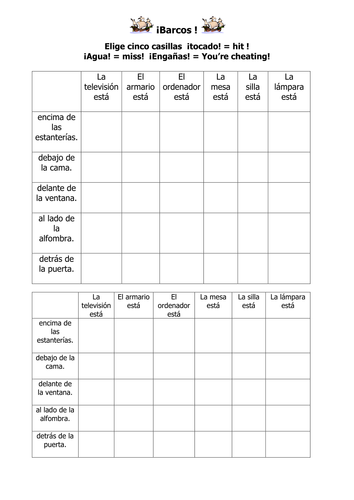

Expressions:
Una cama.
un armario.
unas estanterías.
una mesa y una silla.
unos pósters.
una lámpara.
un ordenador y una televisión.
una puerta.
una ventana y unas cortinas.
un equipo de música.
la pared.
una alfombra.
This presentation presents bedroom furniture in Spanish. The first slides have each piece of furniture in Spanish with a picture. The teacher should use this to elicit the meaning in English and drill the pronunciation.
Then there is graded questioning. Firstly there are multiple choice slides followed by what's missing memory game slides.
You can also use the final slide to play a game of "beat the teacher" to revise the learning at the end or during the following lesson.
Beat the Teacher is played like this:
The teacher points to a picture and says a word. If it is the correct word the students all repeat it. If its the wrong word the students must stay absolutely silent. If they do, they win 1 point. If not, the teacher gets 1 point. Most points wins!
Battleships Expressions:
La televisión está
El armario está
El ordenador está
La mesa está
La silla está
La lámpara está
encima de las estanterías.
debajo de la cama.
delante de la ventana.
al lado de la alfombra.
detrás de la puerta.
I use this battleships game (which can also be used as a lotto grid) to help students to practise their pronunciation and to reinforce new vocabulary and grammatical structures.
Firstly I ask the students to work independently in pairs to translate the expressions.
I then check the translations and drill pronunciation with the whole class before they play the game. The students secretly choose 5 squares on the top grid and then try to guess which 5 squares their partner has chosen, filling in the bottom grid with “hit” and “miss.” To choose a square say a phrase from the horizontal line and complete the sentence with a phrase from the vertical line. Where the 2 phrases meet up is the square you have chosen.
I use the English language sheet to further challenge the students: they should place this on top of the Spanish version and then try to play the game saying the Spanish phrases as far as possible from memory. I allow the really weak students to have the Spanish version next to the English version so they have lots of support, stronger students are allowed a few “sneaky peaks” at the Spanish version and the really strong students aim to refer back to the Spanish version as little as possible. This really helps the students to memorise the vocabulary/structures!
During the game I circulate the classroom checking pronunciation.
Enjoy!
Una cama.
un armario.
unas estanterías.
una mesa y una silla.
unos pósters.
una lámpara.
un ordenador y una televisión.
una puerta.
una ventana y unas cortinas.
un equipo de música.
la pared.
una alfombra.
This presentation presents bedroom furniture in Spanish. The first slides have each piece of furniture in Spanish with a picture. The teacher should use this to elicit the meaning in English and drill the pronunciation.
Then there is graded questioning. Firstly there are multiple choice slides followed by what's missing memory game slides.
You can also use the final slide to play a game of "beat the teacher" to revise the learning at the end or during the following lesson.
Beat the Teacher is played like this:
The teacher points to a picture and says a word. If it is the correct word the students all repeat it. If its the wrong word the students must stay absolutely silent. If they do, they win 1 point. If not, the teacher gets 1 point. Most points wins!
Battleships Expressions:
La televisión está
El armario está
El ordenador está
La mesa está
La silla está
La lámpara está
encima de las estanterías.
debajo de la cama.
delante de la ventana.
al lado de la alfombra.
detrás de la puerta.
I use this battleships game (which can also be used as a lotto grid) to help students to practise their pronunciation and to reinforce new vocabulary and grammatical structures.
Firstly I ask the students to work independently in pairs to translate the expressions.
I then check the translations and drill pronunciation with the whole class before they play the game. The students secretly choose 5 squares on the top grid and then try to guess which 5 squares their partner has chosen, filling in the bottom grid with “hit” and “miss.” To choose a square say a phrase from the horizontal line and complete the sentence with a phrase from the vertical line. Where the 2 phrases meet up is the square you have chosen.
I use the English language sheet to further challenge the students: they should place this on top of the Spanish version and then try to play the game saying the Spanish phrases as far as possible from memory. I allow the really weak students to have the Spanish version next to the English version so they have lots of support, stronger students are allowed a few “sneaky peaks” at the Spanish version and the really strong students aim to refer back to the Spanish version as little as possible. This really helps the students to memorise the vocabulary/structures!
During the game I circulate the classroom checking pronunciation.
Enjoy!
Something went wrong, please try again later.
This resource hasn't been reviewed yet
To ensure quality for our reviews, only customers who have purchased this resource can review it
Report this resourceto let us know if it violates our terms and conditions.
Our customer service team will review your report and will be in touch.
£2.00
